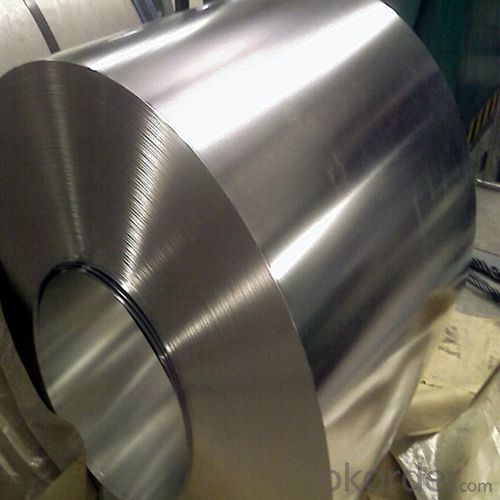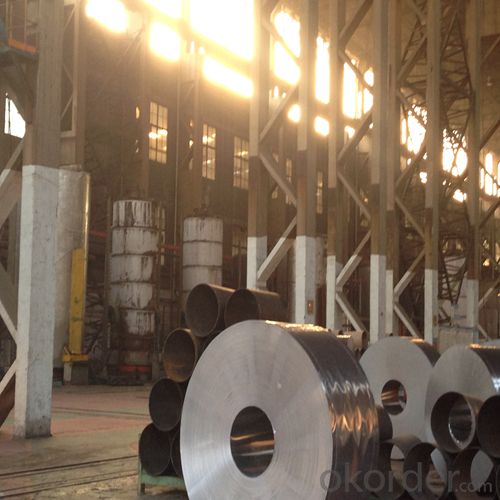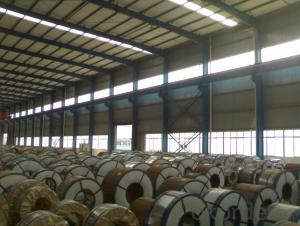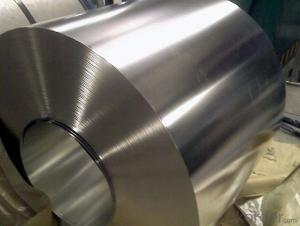Electrolytic Tinplate Coil for Foods and Chemical Cans Packing
- Loading Port:
- Tianjin
- Payment Terms:
- TT OR LC
- Min Order Qty:
- 25 m.t
- Supply Capability:
- 7000 m.t/month
OKorder Service Pledge
OKorder Financial Service
You Might Also Like
1.Structure of Electrolytic Tinplate Coil for Foods and Chemical Cans Packing Description
Electrolytic Tin Plate Coils and Sheets for Foods Metal Packaging, is one thin steel sheet with a coating of tin applied by electrolytic deposition. Tinplate made by this process is essentially a sandwich in which the central core is strip steel. This core is cleaned in a pickling solution and then fed through tanks containing electrolyte, where tin is deposited on both sides. As the strip passes between high-frequency electric induction coils, it is heated so that the tin coating melts and flows to form a lustrous coat.
2.Main Features of the Electrolytic Tinplate Coil for Foods and Chemical Cans Packing
Appearance – Electrolytic Tin Plate is characterized by its beautiful metallic luster. Products with various kinds of surface roughness are produced by selecting the surface finish of the substrate steel sheet.
Paintability and printability – Electrolytic Tin Plates have excellent paintability and printability. Printing is beautifully finished using various lacquers and inks.
Formability and strength – Electrolytic Tin Plates have got very good formability and strength. By selecting a proper temper grade, appropriate formability is obtained for different applications as well as the required strength after forming.
Corrosion resistance – Tinplate has got good corrosion resistance. By selecting a proper coating weight, appropriate corrosion resistance is obtained against container contents. Coated items should meet 24 hour 5 % salt spray requirement.
Solderability and weldability – Electrolytic Tin Plates can be joined both by soldering or welding. These properties of tinplate are used for making various types of cans.
Hygienic – Tin coating provides good and non toxic barrier properties to protect food products from impurities, bacteria, moisture, light and odours.
Safe – Tinplate being low weight and high strength makes food cans easy to ship and transport.
Eco friendly – Tinplate offers 100 % recyclability.
Tin is not good for low temperature applications since it changes structure and loses adhesion when exposed to temperatures below – 40 deg C.
3.Electrolytic Tinplate Coil for Foods and Chemical Cans Packing Images



4.Electrolytic Tinplate Coil for Foods and Chemical Cans Packing Specification
Standard | ISO 11949 -1995, GB/T2520-2000,JIS G3303,ASTM A623, BS EN 10202
|
Material | MR,SPCC |
Thickness | 0.15mm - 0.50mm |
Width | 600mm -1150mm |
Temper | T1-T5 |
Annealing | BA & CA |
Coil Inner Diameter | 508mm |
Weight | 6-10 tons/coil 1~1.7 tons/sheets bundle |
Passivation | 311 |
Oil | DOS |
Surface | Finish,bright,stone,matte,silver |
5.FAQ of Electrolytic Tinplate Coil for Foods and Chemical Cans Packing
-What your tinplate material is used for ?
Tinplate is widely used for the packaging of products. Such as food cans,
beverage cans, pet cans, closures, general line cans and so on.
Printed Tinplate is offered!!
-How to place .an order or contact you ?
Please send us Email. we will give you a quick response in seconds .
- Q:What are the advantages of using tinplate for aerosol cans?
- Some advantages of using tinplate for aerosol cans include its durability, corrosion resistance, and ability to maintain product quality. Tinplate cans offer a longer shelf life for aerosol products as they prevent air and moisture from entering the can, ensuring the product remains fresh and effective. Additionally, tinplate cans are lightweight, making them convenient for transportation and storage. They are also recyclable, contributing to sustainability efforts.
- Q:How does tinplate compare to plastic-coated steel in terms of properties and applications?
- Tinplate and plastic-coated steel differ in terms of properties and applications. Tinplate offers excellent corrosion resistance and can be easily soldered, making it suitable for food and beverage packaging, aerosol cans, and decorative items. On the other hand, plastic-coated steel provides enhanced durability, impact resistance, and chemical resistance, making it ideal for automotive parts, electrical enclosures, and construction applications. Ultimately, the choice between the two depends on the specific requirements of the intended application.
- Q:What are the regulations and standards related to tinplate packaging?
- The regulations and standards related to tinplate packaging vary depending on the country and industry. However, some common regulations and standards include ensuring the tinplate packaging materials are food-grade and safe for consumers, complying with labeling requirements such as product information and warnings, and meeting environmental regulations for packaging waste management. Additionally, tinplate packaging may need to adhere to specific industry standards like those set by the International Organization for Standardization (ISO) or specific regulatory bodies such as the United States Food and Drug Administration (FDA).
- Q:Is to buy canned tinplate or aluminum
- Tinplate, our company sells tinplate
- Q:What are the different ways to seal tinplate cans?
- There are several different ways to seal tinplate cans. Some common methods include double seam sealing, soldering, welding, and adhesive bonding. Each method has its own advantages and suitability based on factors like the type of product being stored, the desired level of sealing integrity, and the production process.
- Q:How does tinplate contribute to the safety of toys?
- Tinplate contributes to the safety of toys by providing a protective coating that prevents direct contact between the toy and any potentially harmful substances. This coating acts as a barrier against corrosion, ensuring that the toy remains safe and free from any toxic materials that may be present in the metal or paint used. Additionally, tinplate is durable and resistant to damage, reducing the risk of children being exposed to sharp edges or broken pieces.
- Q:What are the characteristics of different tin process
- Shapes: tinplate cans can be made into various shapes according to different needs, such as cans, cans, cans, circular elliptical horseshoe and trapezoid etc, can satisfy the different needs of product packaging, and the packaging container more change, promote sales. 6. recyclable: in line with international environmental requirements, in line with future product trends.
- Q:What are the recommended soldering techniques for tinplate?
- The recommended soldering techniques for tinplate typically involve using a low temperature solder and a clean, well-heated soldering iron. It is important to pre-tin both the tinplate surface and the soldering iron tip before attempting to join the pieces. Additionally, ensuring a good mechanical connection between the tinplate pieces and using flux to promote better solder flow can greatly improve the soldering results.
- Q:How does tinplate perform in terms of light protection?
- Tinplate performs well in terms of light protection due to its opaque nature, which helps to block out light and prevent the entry of harmful UV rays.
- Q:What is the purpose of tin coating on tinplate?
- The purpose of tin coating on tinplate is to provide a protective layer that prevents the iron from rusting and extends the shelf life of the product. Additionally, the tin coating enhances the appearance of the tinplate, making it more visually appealing to consumers.
1. Manufacturer Overview |
|
|---|---|
| Location | |
| Year Established | |
| Annual Output Value | |
| Main Markets | |
| Company Certifications | |
2. Manufacturer Certificates |
|
|---|---|
| a) Certification Name | |
| Range | |
| Reference | |
| Validity Period | |
3. Manufacturer Capability |
|
|---|---|
| a)Trade Capacity | |
| Nearest Port | |
| Export Percentage | |
| No.of Employees in Trade Department | |
| Language Spoken: | |
| b)Factory Information | |
| Factory Size: | |
| No. of Production Lines | |
| Contract Manufacturing | |
| Product Price Range | |
Send your message to us
Electrolytic Tinplate Coil for Foods and Chemical Cans Packing
- Loading Port:
- Tianjin
- Payment Terms:
- TT OR LC
- Min Order Qty:
- 25 m.t
- Supply Capability:
- 7000 m.t/month
OKorder Service Pledge
OKorder Financial Service
Similar products
New products
Hot products
Hot Searches
Related keywords





























